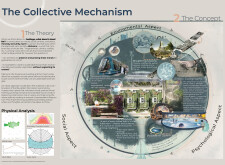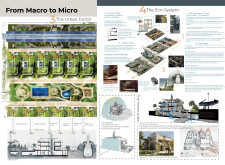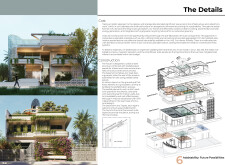5 key facts about this project
**Overview**
Located within a context that emphasizes the integration of nature and built environments, the project reflects a holistic and sustainable approach to residential architecture. It aims to create living spaces that honor moral heritage while addressing contemporary social and environmental challenges. The design seeks to balance environmental, social, and psychological aspects, fostering a vibrant community that remains anchored in its roots and contextual awareness.
**Spatial Strategy**
The architectural layout is organized around a steel frame, with prefabricated panels facilitating efficient construction. The interior design employs a grid system, maximizing flexibility and usability to accommodate diverse community needs. Various zones are designated for distinct functions, including formal living areas, communal gardens, and multifunctional workspaces. Shared amenities, such as the adaptable kitchen and communal outdoor spaces, support social interactions while providing privacy options where necessary. This design approach not only enhances visual connectivity and flow but also cultivates an environment conducive to both community engagement and individual comfort.
**Materiality and Sustainability**
The project employs a range of sustainable materials that align with its eco-friendly ethos. Autoclaved Aerated Concrete (AAC) panels serve as the primary load-bearing elements, known for their lightweight and insulative properties. Sandwich panels are utilized for interior walls, chosen for their cost-effectiveness. Bamboo charcoal veneer highlights the interior finishes, combining aesthetic appeal with sustainability. The inclusion of steel mesh structures optimizes water collection and flexibility, while green facades integrate vegetation into the design, supporting cooling and biodiversity. Additionally, innovative features such as rainwater harvesting and district cooling systems are incorporated to ensure minimal environmental impact while promoting energy efficiency. The design elements are further enhanced by the integration of local cultural motifs, such as Arabic calligraphy, contributing to a distinctive architectural identity.






















































